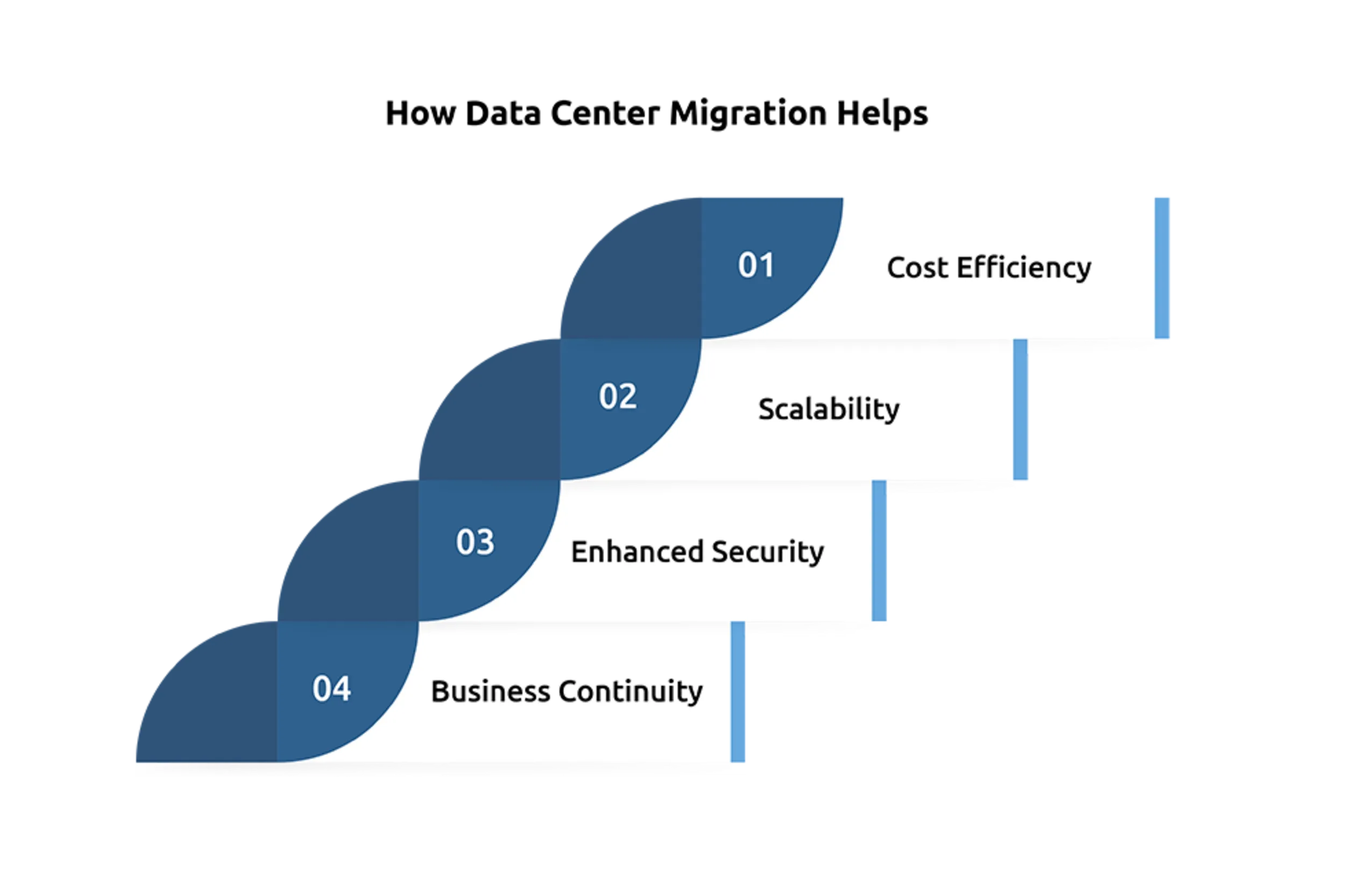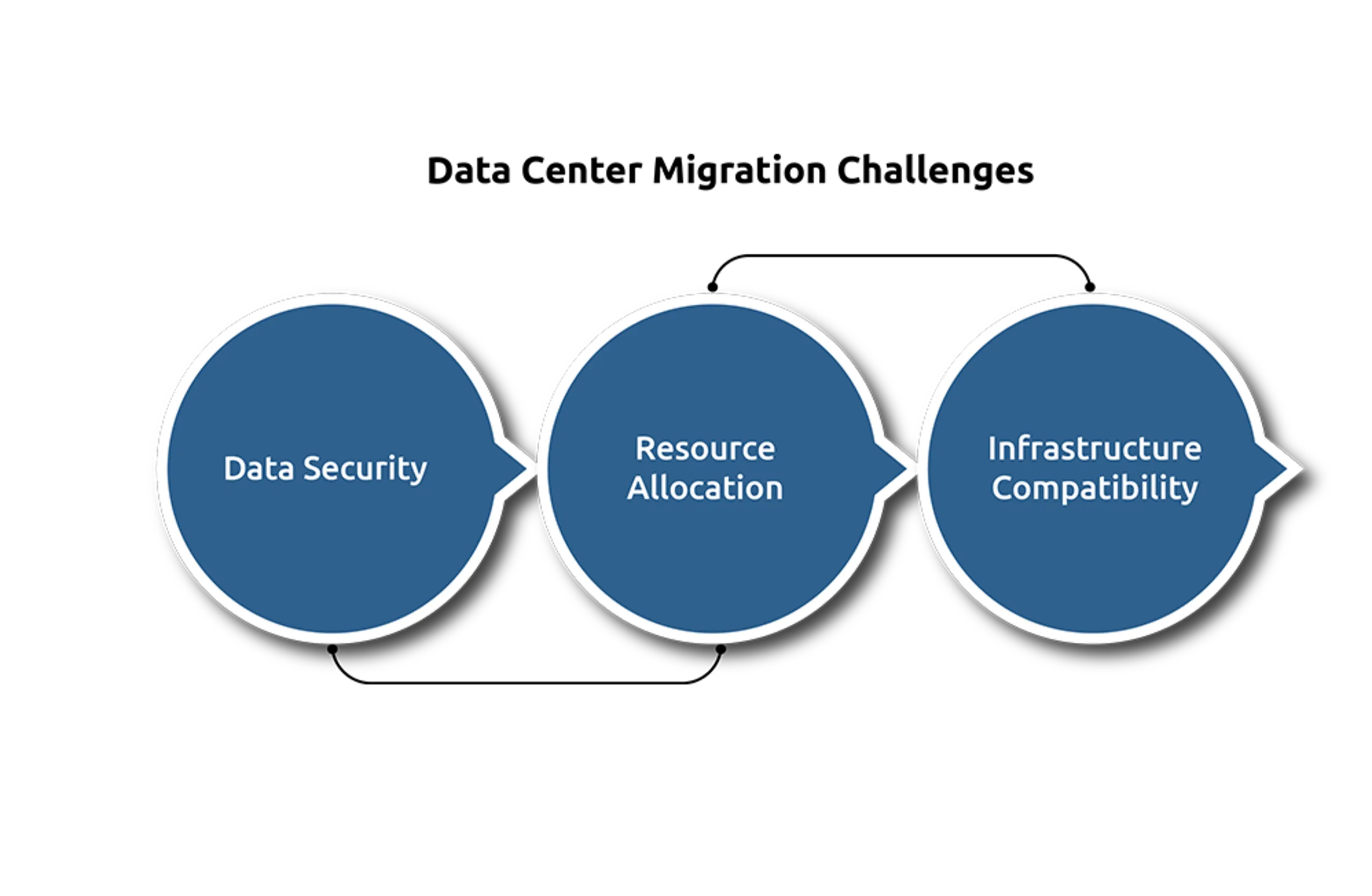Data center relocation is also known as migration, involving IT resources such as servers, storage systems, and networking hardware to a new location while maintaining operational continuity. In 2024, data center relocation will become increasingly difficult for businesses looking to improve IT infrastructure, make sure scalability, or shift to hybrid or cloud environments.
Key Challenges:
- Minimizing Downtime: Downtime during relocation can disrupt operations. Detailed planning and phased migration strategies are needed to reduce this risk.
- Data Security: Securing useful data during the move requires stringent security measures with regulations.
- Resource Optimization: Ensuring efficient allocation of hardware, personnel, and budget is difficult to maintain perfect migration.
- Infrastructure Compatibility: making sure of compatibility with the new facility’s power, cooling, and regulatory requirements can be challenging.
- Cloud Integration: Incorporating cloud services into data center migration requires careful consideration of hybrid environments and application dependencies.
Data Center Migration and its need
Data center relocation refers to the process of a data center’s IT infrastructure, applications, and to a new location, cloud platform, or hybrid environment. This is driven by the need to improve performance, cost optimization, scalability, and business continuity. Organizations often migrate to adopt modern technologies, improve disaster recovery capabilities, and reduce operational risks associated with outdated infrastructure. The rise of cloud adoption, stricter regulatory requirements, and sustainability goals have also made migration critical for ensuring alignment with modern business demands
How Data Center Migration Helps
Here is the updated and changed content on how data center migration helps, incorporating the latest insights:
How Data Center Migration Helps
- Cost Efficiency: Modernizing IT infrastructure through data center migration reduces energy consumption and maintenance costs. Updated systems are more efficient, avoiding frequent repair costs associated with outdated hardware. Cloud-based solutions further minimize costs by reducing the need for on-premises maintenance.
- Scalability: Migrated data centers, especially those that use cloud services, provide flexible scalability to adapt to business needs. Organizations can increase or decrease resources on demand without the cost and difficulties of repairing physical infrastructure.
- Enhanced Security: Modern data centers give best security protocols, including encryption, access controls, and disaster recovery options. This is to ensure data integrity and protection from cyber threats, making them more secure than legacy systems.
- Business Continuity: Migrated environments often adding duplication and failover mechanisms. In the event of hardware failure, natural disasters, or other disruptions, these systems make sure minimal downtime, maintaining operational continuity.
- Simplified Management: Data center migration centralizes IT infrastructure management. This streamlined approach improves monitoring, simplifies updates, and increases the productivity of IT teams, especially when combined with automated tools and cloud platforms.

Data Center Migration Challenges
Reduces Downtime: making sure uninterrupted operations during migration is difficult to avoid loss of productivity and profit.
Data Security: Protecting important data and meeting regulatory compliance are top priorities during the transition.
Resource Allocation: Budget, hardware, and staffing must be properly managed to avoid delays and financial access.
Infrastructure Compatibility: Addressing power, cooling, and regulatory differences between the old and new environments can be difficult.
Technical Complexity: Moving and reassembling IT equipment safely requires specialized expertise to prevent damage and data loss
Post-Migration Testing: Includes thorough testing, monitoring, and maintenance to ensure optimal performance in the new environment.

Comprehensive Relocation Services
A successful data center relocation needed complete planning and the right strategy to reduce downtime and make sure a smooth transition. The choice between a ‘big bang’ approach, which is fast but risky, as it requires immediate full operational capability, and a phased approach, which reduces risk but requires more time and resources, depends on the scale and difficulties of the data center. Engaging experienced professionals with proven expertise helps minimize uncertainty and risks throughout the process. Working closely with clients, our solutions address all of the moves, ensuring efficiency, security, and minimal disruption.
Strategic Planning for Minimal Disruption
Strategic planning for data center relocation is needed to reduce disruption and make sure a smooth transition. This includes a detailed assessment of the infrastructure, identifying potential risks, and defining a clear timeline and resource allocation. Developing a roadmap with a phased migration can reduce downtime, ensuring business continuity. Close collaboration with experienced relocation experts is needed to deal with technical difficulties and security measures. Proper communication with stakeholders and conducting thorough testing post-move make sure that everything runs easily and meets performance expectations.
Secure Transportation of Critical Assets
Establishing secure transportation for key resources is crucial during data center migration. A detailed inventory of the hardware, including its condition, weight, and serial number, is taken before transportation. The equipment is packed using anti-static materials to prevent damage, while vehicles with air ride suspension systems ensure a smooth journey. Strong security protocols, such as data encryption, are implemented to protect sensitive information. Expert handling by professionals and stringent security measures protect both critical data and physical assets throughout the relocation process.
Solutions and Best Practices:
- Strategic Planning: Comprehensive inventory management, resource allocation, and risk assessment are vital for a smooth transition.
- Expert Collaboration: Engaging specialists with proven track records in data center migration ensures technical expertise and risk mitigation.
- Phased Migration: Gradually moving workloads in stages reduces downtime, improves testing capabilities, and ensures better flexibility.
- Post-Migration Optimization: Testing systems, monitoring network performance, and routine maintenance help optimize IT infrastructure in the new location.






